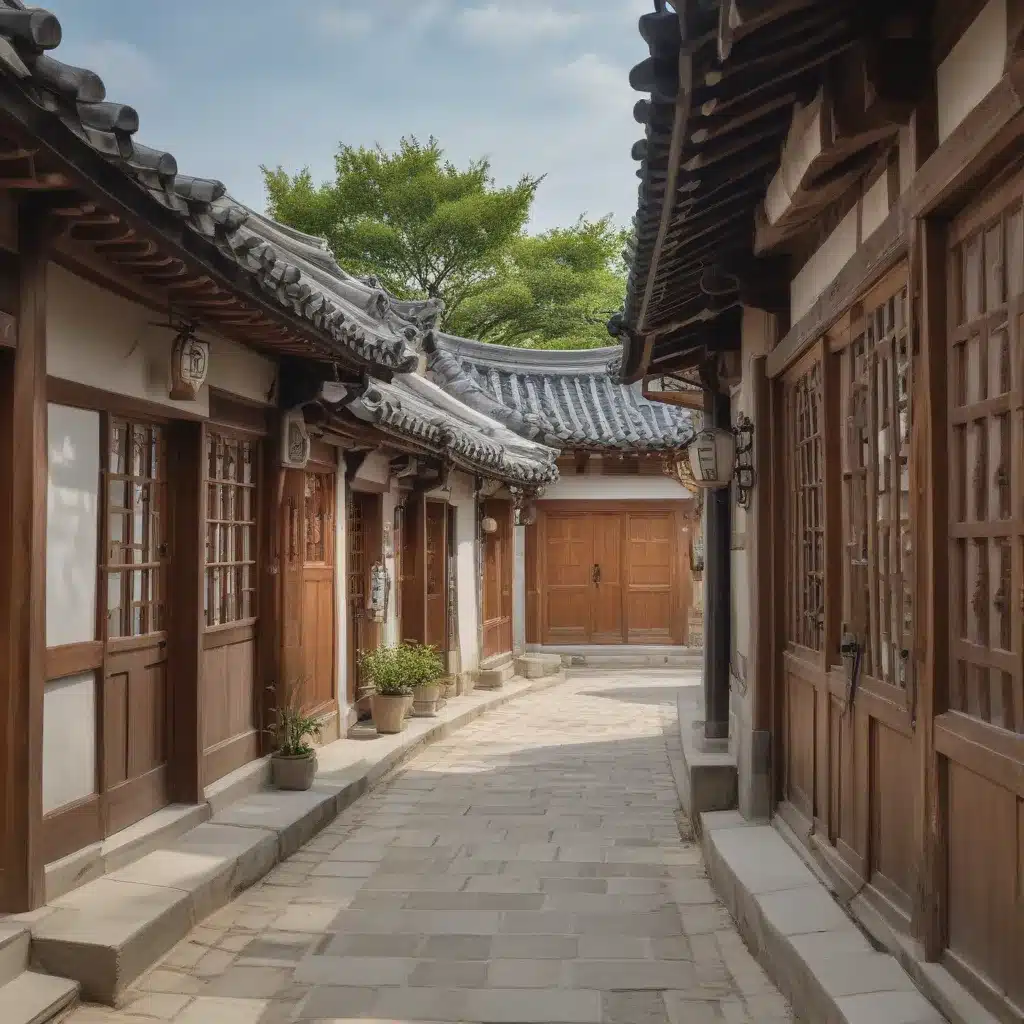
Exploring Seoul’s Enchanting Neighborhood of Traditional Homes
As I stepped out of the bustling streets of Seoul, the vibrant capital of South Korea, I found myself transported back in time. The towering skyscrapers and neon-lit shopping districts gave way to a serene enclave of traditional Korean homes, known as the Bukchon Hanok Village.
This enchanting neighborhood, nestled between the iconic Gyeongbokgung Palace and the Cheonggyecheon Stream, promised to take me on a journey through the rich cultural heritage of Korea. With a guidebook in hand and a curiosity that piqued my interest, I set out to explore this unique slice of history.
Discovering the Essence of Hanok Architecture
As I wandered through the narrow, winding alleyways of Bukchon, I was immediately captivated by the intricate beauty of the Hanok, the traditional Korean houses that lined the streets. These architectural marvels, with their distinctive curved roofs, wooden frames, and intricate lattice work, were a testament to the ingenuity and craftsmanship of Korea’s past.
According to the Svadore travel blog, the Hanok homes in Bukchon were built during the Joseon Dynasty, which spanned from the 14th to the 19th century. These structures were designed to blend seamlessly with the natural landscape, utilizing the principles of geomancy to create a harmonious living environment.
As I wandered through the village, I couldn’t help but be struck by the attention to detail in every aspect of the Hanok design. The curved roofs, crafted from traditional Korean tiles, not only added to the aesthetic appeal but also served practical purposes, such as channeling rainwater and providing insulation. The wooden frames, meticulously crafted, stood as sturdy as they were centuries ago, a testament to the durability of traditional construction techniques.
Immersing Myself in the Cultural Experience
One of the highlights of my visit to Bukchon Hanok Village was the opportunity to step inside these historic homes and truly experience the essence of Korean culture. As the bloggers at Adventures of the 4JLs noted, many of the Hanok houses in Bukchon have been converted into cultural centers, guesthouses, and tea houses, allowing visitors to immerse themselves in the traditional way of life.
I had the chance to don a traditional Korean Hanbok, the colorful and ornate clothing that was once reserved for the upper echelons of society. As I strolled through the narrow alleys, I couldn’t help but feel like a time traveler, blending seamlessly with the historical surroundings. The intricate patterns and vibrant hues of the Hanbok added an extra layer of authenticity to my experience, transporting me to a bygone era.
In addition to the Hanbok rental, the Hanok houses also offered opportunities to participate in traditional Korean cultural activities, such as tea ceremonies and cooking classes. I eagerly signed up for a tea tasting session, where I learned about the intricate art of brewing and serving the perfect cup of Korean green tea. The serene atmosphere of the traditional tea house, complete with gentle music and serene decor, created a truly memorable experience that allowed me to appreciate the nuances of Korean culture.
Exploring the Historic Landmarks
As I ventured deeper into Bukchon Hanok Village, I discovered that the neighborhood was not just a living museum of traditional architecture, but also a hub of historic significance. The Food and Travel Guides blog highlighted the close proximity of Bukchon to the iconic Gyeongbokgung Palace, the main royal palace of the Joseon Dynasty.
I made my way to the grand Gwanghwamun Gate, the main entrance to the palace, and was greeted by the impressive sight of the imposing structure. As I passed through the gate, I couldn’t help but imagine the countless generations of Korean royalty and nobility who had walked these same grounds, witnessing the ebb and flow of the country’s dynamic history.
Within the palace grounds, I was captivated by the stunning Geunjeongjeon Hall, the main throne room where the king would hold court and receive important guests. The intricate architecture, with its ornate carvings and intricate paintings, provided a glimpse into the opulence and grandeur of the Joseon era.
Immersing in the Vibrant Street Life
As I tore myself away from the historic landmarks and returned to the streets of Bukchon, I was struck by the vibrant energy that permeated the neighborhood. While the Hanok homes and cultural centers offered a glimpse into the past, the streets themselves were a lively tapestry of modern Korean life.
As the bloggers at Adventures of the 4JLs noted, the area between the Gyeongbokgung Palace and Bukchon Hanok Village was a bustling hub of activity, with a variety of local eateries, artisanal shops, and lively street vendors.
I wandered through the lively Insadong neighborhood, where traditional Korean arts and crafts were on full display. From delicate ceramics to intricate calligraphy, the artisans of Insadong showcased the enduring skills and creativity of the Korean people. The aroma of sizzling street food and the jovial chatter of locals and visitors alike created a vibrant, immersive atmosphere that complemented the historic charm of Bukchon.
As the sun began to set, I made my way back to the Hotel Stay Inn Seoul, my home base for this adventure. Reflecting on the day’s experiences, I realized that Bukchon Hanok Village had not just been a historic site, but a living, breathing testament to the enduring spirit of Korean culture. It was a place where the past and present seamlessly intertwined, offering visitors a truly enchanting and unforgettable journey through time.

